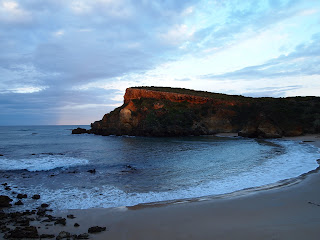
Sydney is fine city with plenty to see and do, containing many hidden gems tucked away in its many neighborhoods and less well-known/touristy areas. But Australia is big country with more than just its most populous city to experience, thus I was feeling slightly restless a month ago, itching to set forth for a time and see more of this diverse and exciting continent. The great Oceanic spirits must have heard my silent cries as a few days later I received a call from my good JMU friend Kevin who had been living in Port Willunga, South Australia, working at a winery there since December. The work had been intense, he told me, but now that he was finished, he wanted to do a road trip on the way to his next gig working at a ski resort in Victoria. Would I be up to a road trip from Adelaide to Sydney, he asked?
Huzzah! Here was the perfect opportunity to hit the road and see a different side of Australian life. So I flew to Adelaide to meet with Kevin, and after we packed Arthur (his ’91 Toyota Corolla purchased for $350) full to the brim with camping equipment, skis, a surfboard, and climbing rope, we began our first Australian road trip.
The plan was simple: work our way from Port Willunga to the Great Ocean Road, which we would follow to Melbourne, then drive up the coast from there to Sydney.
There was no timetable, so we were open to side trips and detours and could generally take our time traversing the 2000 km to Sydney. Since we packed camping equipment and food, we had no need for lodging along the way. When we got hungry, we would just stop at a small town park to cook lunch, then hop back on the road.
We made good distance the first day covering 300 kms and spent the night on the beach outside of Kingston, a small town with a thriving lobster industry, attested to by the giant lobster sculpture at the edge of town.
During the second day of travelling, we said goodbye to South Australia and entered Victoria, intent on beginning the Great Ocean road the next day. We drove another 340 km, passing through historic whaling town Warrnambool just after dusk, having decided to set up camp half an hour down the road at Bay of Islands Coastal Park. All we could tell from the atlas was we were trying to find Childers Cove, which required a stop in a small café in Nullawarre to ask for directions. (“You make a right at the corner, then a left, mumblemumblemumble and you should be there”) After wandering lost in the dark for a bit we finally arrived at our destination, tired and hungry, but the view of the cove we were greeted with in the morning was well worth the hassle of getting there.
It was clear after waking to the spectacular view of Childers Cove Sunday morning that to get maximum enjoyment out of our trip, our greatest ally would be improvisation and the ability to adapt. We’d be crossing the Great Ocean Road during the off season, and without all the other holiday travellers clogging the road, we were much freer to make up our plans on the fly from day to day.
The only rule: don’t fall off.
Coming up: Kevin and I begin the Great Ocean Road, our campsite is overrun by koalas, and the surfboard becomes a nuisance. But with 414,000 km on the odometer, how much further can Arthur go?





















